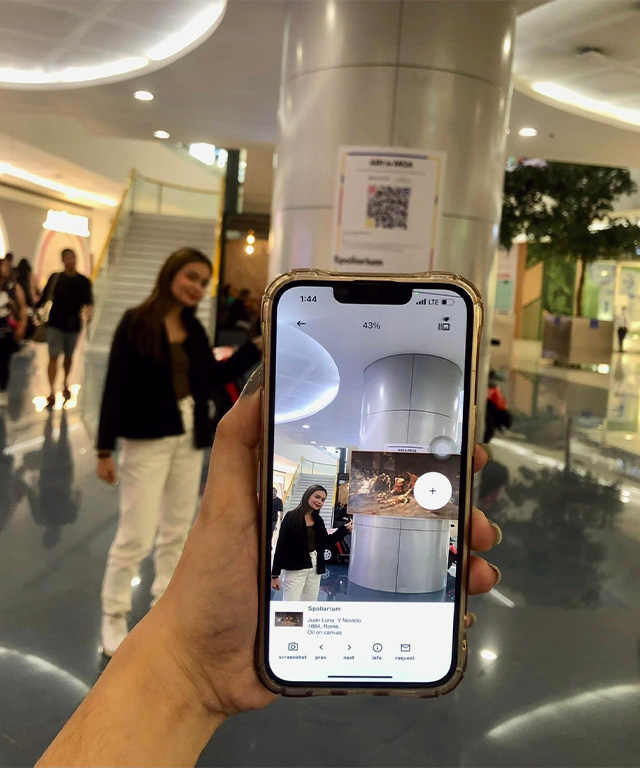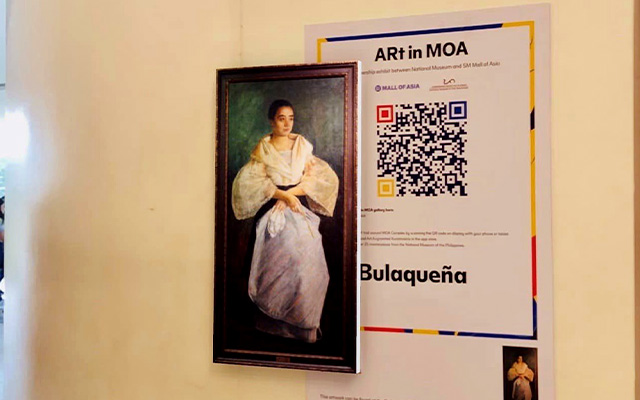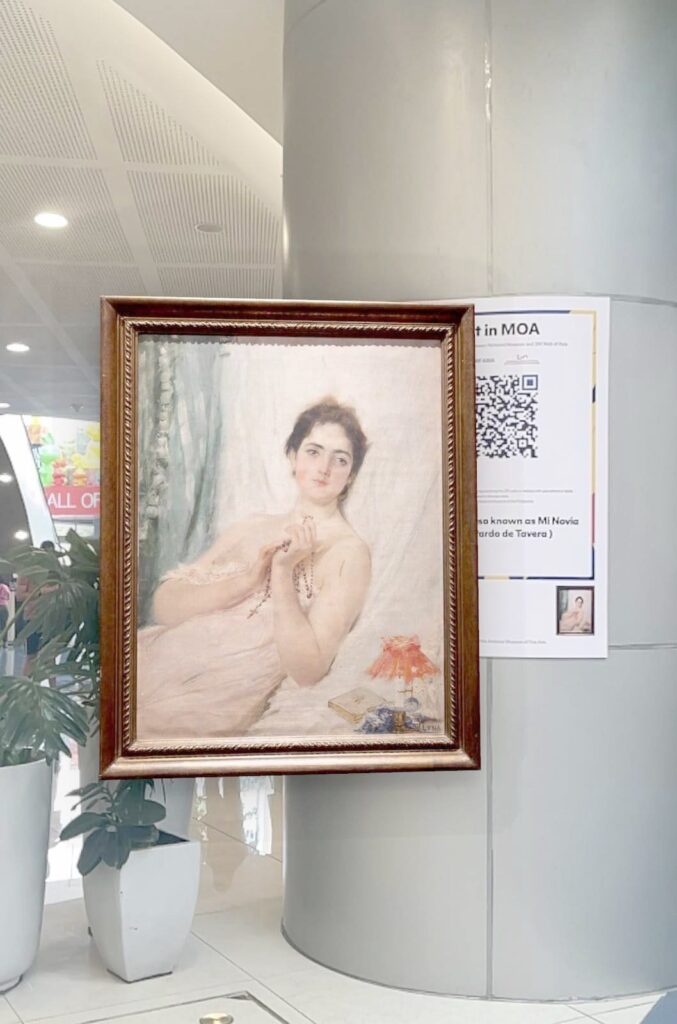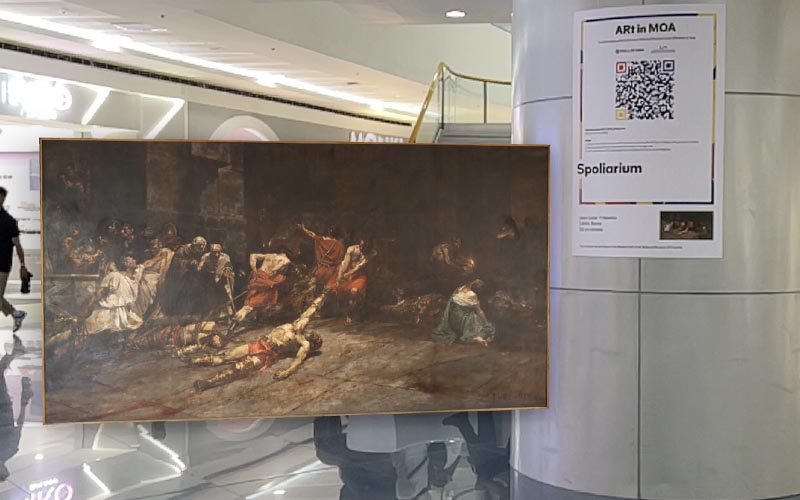EVER dreamed of hanging artworks by distinguished Filipino artists around your home? Well, now you can for free, thanks to augmented reality, or AR as it is known.
It may sound surprising, but you can do just that with 25 works in the National Museum of the Philippines collection – the only catch is they will not physically be there but can be seen virtually via an app on your smartphone.
Just scan the huge QR codes plastered around the SM Mall of Asia (MOA), S Maison and MOA Square on your gadget. Then you’ll get a glimpse of some of the National Museum’s finest paintings. A collaboration with SM MOA, “ARt in MOA” is a free art exhibit that brings the National Museum of Fine Arts’ most sought-after pieces to life through AR. It runs until Aug. 30.

Catch this one-of-a-kind event that brings key pieces of Philippine art closer to everyone through a pop-up show on the second floor of MOA as well as through QR codes placed around the mall complex. Some of the artworks that can be found in the AR exhibit are Juan Luna’s Spoliarium and La Bulaqueña, Ang Kiukok’s Ink Fish, Carlos V. Francisco’s The Presentation of Santo Niño in Cebu, Norma Belleza’s Pottery Makers, Felix Resurreccion Hidalgo’s El Asesinato del Gobernador Bustamante, Fernando Amorsolo’s Bataan and Guillermo Tolentino’s Lualhati.
Art enthusiasts can explore the paintings in 3D using the camera on their phones. This offers a new opportunity for virtual engagement – one that brings you up close with objects in the National Museum collection, especially for those who can’t visit the place. This mix of art and technology means you can virtually interact with the pieces sans the fear of damaging the precious artworks.

After you’ve explored the treasured pieces, bring them into your space – place the object and snap a screengrab to capture how it looks wherever you are. What would Juan Luna’s Spoliarium look like on your bedroom wall? How about showing off Fernando Amorsolo’s Bataan in your living room? Through AR, you can do that and more – no matter where you are.
Indeed, “ARt in MOA” is a great example of how AR is enhancing the museum experience. It also enables viewers to get their art fix by positioning digital works onto surfaces inside and outside the home fusing sci-fi with reality.
How to view AR artworks
Download the Art.Augmented Kunstmatrix app on your mobile device. This application is available on both App Store and Google Play Store.
Scan the QR codes with your camera.
Press the “+” button to add the artwork to your screen.
Take as many pictures of the art pieces as you wish. You can even move your camera around to find the perfect lighting and background to make the snap worthy of your Instagram feed. Once you’ve downloaded the app and brought the photo up on the screen, you can play around with the painting’s scale by zooming in or out with your fingers. You can bring the object to life anywhere once you’ve downloaded the app.


Bringing PH art to wider audience
The partnership between the National Museum and SM MOA is the first collaboration of its kind for both parties. The National Museum was represented by director-general Jeremy Barns and deputy director-general for museums Jorell Legaspi, while SM was represented by senior assistant vice president of mall operations, Perkin O. So, and assistant vice president for marketing, Krisel Raymundo-Ramilo.
At the signing of the memorandum of agreement, Legaspi said, “The National Museum looks forward to making other programs with SM that will be beneficial for both organizations because our role to the Filipino people is to provide enjoyment, entertainment and access to our wonderful collection of fine arts and other cultural assets.”
So remarked that “SM is truly honored to be partnering with our friends from the National Museum of the Philippines. We’re truly excited to be able to become a venue to enrich the lives of our customers on a day-to-day basis. We’re excited that the public will be able to experience these creations by the masters in our mall. Hopefully, we can make the public feel the importance and beauty of Philippine art.”
Given the limited reach of Philippine artistic institutions in terms of audience, the objective of the project is to bring Filipino masterpieces to more people via digitization. Aside from increasing accessibility, SM MOA also hopes the general public to better appreciate the rich and vibrant history of our country’s artworks and artists and inspire them to visit the National Museum itself to experience the entire collection.

What is AR?
Imagine being surrounded by ghosts, things that aren’t there unless you look hard enough and in the right way. With AR, that’s possible – and museums around the world have been using it to their advantage. With such technology, museums are superimposing their virtual world right over what’s actually in front of you, bringing exhibits and artifacts to life in new ways.
AR is the process of using technology to superimpose images, text or sounds on top of what a person can already see. It uses a smartphone or tablet to alter the existing picture, via an app. The user stands in front of a scene and holds up their device. It will show them an altered version of reality.
A few of the most well-known applications of AR are from the gaming world. For example, Pokémon Go, the game where users can “catch” Pokémon hiding in the world around them. Animated creatures are superimposed onto what players can see through their device’s camera. The technology makes them appear as if they are existing in the real world. The app has been downloaded over one billion times. This shows that AR is accessible and has the potential to reach a huge audience.
Museums and curators are already full of knowledge and the desire to engage people in a dialogue. AR is another tool that can communicate this knowledge. It invites visitors to find out more. A virtual rendition of an artist narrating his work has the potential to encourage more engagement. A skeleton that comes to life can help visitors understand new concepts. AR can even help contextualize history by blending the old and the new. For example, it can show historical scenes superimposed onto modern ones.
This technology can capture people’s attention and keep their focus on exhibitions for longer. Before opening their AR installation, the Art Gallery of Ontario in Canada did a survey. It discovered most visitors to the museum’s collections spent on average only 2.31 seconds in front of each image. In a busy modern life where visitors are not always inclined to linger, museums can use AR to reach out and grab their attention.





